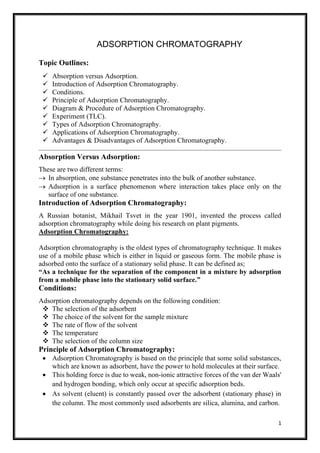
Adsorption Chromatography Assignment.pdf
- 1. 1 ADSORPTION CHROMATOGRAPHY Topic Outlines: ✓ Absorption versus Adsorption. ✓ Introduction of Adsorption Chromatography. ✓ Conditions. ✓ Principle of Adsorption Chromatography. ✓ Diagram & Procedure of Adsorption Chromatography. ✓ Experiment (TLC). ✓ Types of Adsorption Chromatography. ✓ Applications of Adsorption Chromatography. ✓ Advantages & Disadvantages of Adsorption Chromatography. Absorption Versus Adsorption: These are two different terms: → In absorption, one substance penetrates into the bulk of another substance. → Adsorption is a surface phenomenon where interaction takes place only on the surface of one substance. Introduction of Adsorption Chromatography: A Russian botanist, Mikhail Tsvet in the year 1901, invented the process called adsorption chromatography while doing his research on plant pigments. Adsorption Chromatography: Adsorption chromatography is the oldest types of chromatography technique. It makes use of a mobile phase which is either in liquid or gaseous form. The mobile phase is adsorbed onto the surface of a stationary solid phase. It can be defined as; “As a technique for the separation of the component in a mixture by adsorption from a mobile phase into the stationary solid surface.” Conditions: Adsorption chromatography depends on the following condition: ❖ The selection of the adsorbent ❖ The choice of the solvent for the sample mixture ❖ The rate of flow of the solvent ❖ The temperature ❖ The selection of the column size Principle of Adsorption Chromatography: • Adsorption Chromatography is based on the principle that some solid substances, which are known as adsorbent, have the power to hold molecules at their surface. • This holding force is due to weak, non-ionic attractive forces of the van der Waals' and hydrogen bonding, which only occur at specific adsorption beds. • As solvent (eluent) is constantly passed over the adsorbent (stationary phase) in the column. The most commonly used adsorbents are silica, alumina, and carbon.
- 2. 2 Adsorption Chromatography Diagram: Adsorption Chromatography Procedure: Before beginning an adsorption chromatography experiment, we must recognize the various components essential to perform the process. o Stationary phase: The stationary phase of adsorption chromatography is adsorbent. o Mobile phase: In adsorption chromatography, either a liquid or a gas is used as a mobile phase. Apparatus: ▪ Chromatography jar: The glass jar has a lid. It helps to maintain a proper environment during separation. ▪ Thin-layer chromatography plate: Silicate glass plate with size 20*20 cm, 20*5 cm, 20*10. ▪ Capillary tube: Sample mixture is applied to TLC with the help of this tube. ▪ Mobile phase: Liquid or gas. ▪ Stationary phase: Adsorbents.
- 3. 3 Experiment (TLC): o Take a clean and dry chromatographic jar. o To make sure that the environment in the jar is saturated with solvent vapors, a paper soaked in the mobile phase is applied to the walls. o Add the mobile phase to the jar and close it and maintain equilibrium o Mark the baseline on the adsorbent. o Apply sample to TLC plate with the help of a capillary tube and allow it to dry. Put the plates in the jar and close it. o Wait until the solvent moves from the baseline. o Take out the TLC plate and dry it. Types of Adsorption Chromatography: These are some important types of Adsorption Chromatography. 1. Thin Layer Chromatography (TLC). 2. Paper Chromatography. 3. Column Chromatography. 4. Gas-Solid Chromatography. 1- Thin Layer Chromatography (TLC): It is an analytical method of separation used for qualitative analysis and monitoring of the reaction as well as identifying unknown compounds. In which the mobile phase moves over an adsorbent. 2- Paper Chromatography: It is a technique that uses paper sheets or strips as the adsorbent being the stationary phase through which a solution is made to pass is called paper chromatography. The solid surface of the paper is the stationary phase and the liquid phase is the mobile phase. 3- Column Chromatography: It is a commonly used technique for separating the compounds from the sample mixture. It is used on small or large scans to separate and purify compounds. The mixture of samples moves through the stationary phase with the mobile phase and based on various degrees of adhesion it separates the compounds. 4- Gas-Solid Chromatography: It is an analytical method for the separation of volatile compounds in which the mobile phase is gas and the stationary phase is suitable for solid support. The gas-solid chromatography, work on the principle of separation is adsorption and generally used for samples that had less solubility in the stationary phase. Adsorption Chromatography Applications: Adsorption chromatography have the various applications: • It is used for the separation of amino acids. • It is used in the isolation of antibiotics.
- 4. 4 • It is used in the identification of carbohydrates. • It is used to determine the concentration of a molecule. • It is used for the separation and identification of isomers. • Used to isolate and determine various peptides and proteins. Advantages of adsorption chromatography: The advantages of adsorption chromatography are as follows. ▪ Adsorption chromatography is an important tool for separating many molecules that cannot be distinguished from other methods. ▪ Adsorption chromatography uses a broad range of mobile phases. ▪ The molecules in the complex mixture can be easily separated. ▪ Very few types of equipment are used as opposed to other separation methods. Disadvantages of adsorption chromatography: The disadvantages of adsorption chromatography are as follows. ▪ Automation is making it more complicated and expensive. ▪ The major disadvantage of adsorption chromatography is that some solutes have longer retention times. ▪ It can cause catalytic variations in the sample. ▪ Results obtained by some methods of adsorption chromatography are difficult to reproduce. Best of Luck